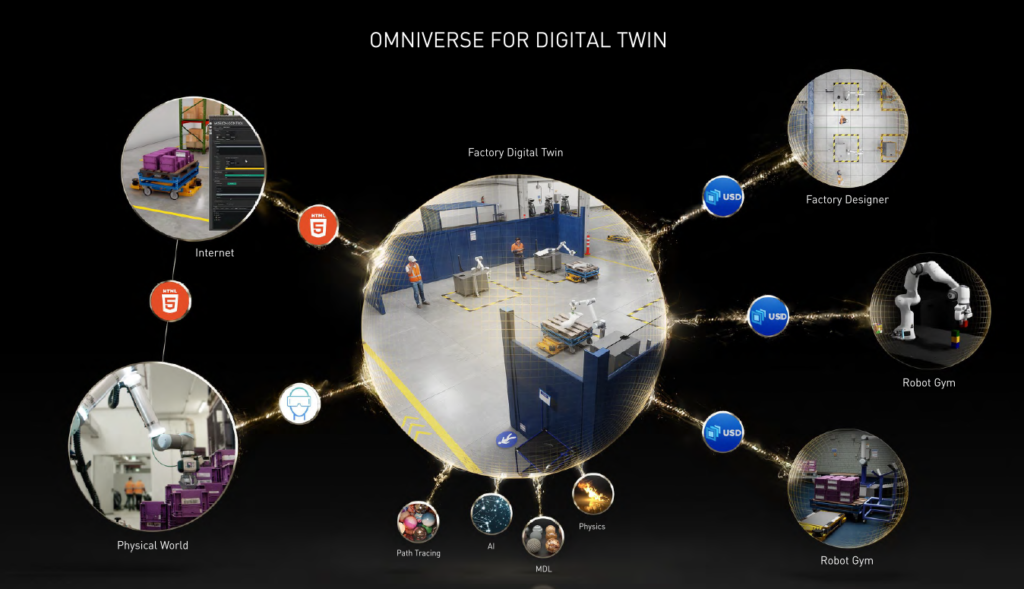Nvidia’s Digital Twin Moonshot – Saving Planet Earth

Nvidia is continuing to expand enterprise digital twin capabilities and features in its Nvidia Omniverse 3D virtual world design platform, but the company’s nascent plans for its grandest digital twin yet might have even bigger impacts after its announcement at this week’s Nvidia GTC21 virtual conference.
The GPU-maker wants to accelerate its digital twin dreams from helping enterprises model products, factories, assembly lines and more – and rev it up to create the grandest digital twin so far – of the planet Earth itself that will continuously model, predict and track climate change in real-time so scientists can seek ways to reverse or stop the destructive effects of its spread.
“We will build a digital twin to simulate and predict climate change,” said Nvidia CEO Jensen Huang during his Nov. 9 keynote at the virtual event. The work will be done using a powerful new supercomputer that the company is now building, called Earth-2, which will run AI physics created by the new Nvidia Modulus AI framework at million-X speeds on the Nvidia Omniverse platform, he said.
“All the technologies we have invented up to this moment are needed to make Earth-2 possible,” said Huang. “I cannot imagine a greater and more important use.”
The Nvidia Modulus AI framework is powered by physics machine learning models that can build neural network models of industrial digital twins which are used by enterprises for a wide range of development and business tasks, as well as for climate science, protein engineering and more, according to Nvidia.
 Digital twins allow data scientists and researchers to conduct experiments and see results by modeling ideas on virtual representations of actual factories, industrial facilities and other physical locations, infrastructure or products, instead of using real-world facilities or products. By using visual representations of real-world items or facilities, development costs and complexity can be reduced, and initial development can be done with far less effort. Digital twin modeling can help a wide range of problems, from a molecular level in drug discovery up to global challenges like climate change, according to Nvidia.
Digital twins allow data scientists and researchers to conduct experiments and see results by modeling ideas on virtual representations of actual factories, industrial facilities and other physical locations, infrastructure or products, instead of using real-world facilities or products. By using visual representations of real-world items or facilities, development costs and complexity can be reduced, and initial development can be done with far less effort. Digital twin modeling can help a wide range of problems, from a molecular level in drug discovery up to global challenges like climate change, according to Nvidia.
In a telephone briefing with technology journalists on Nov. 10, Huang said that Earth-2 will be fully-funded by Nvidia and will add more depth to the company’s existing supercomputer accomplishments, which also include Cambridge-1 and Selene machines.
Nvidia has not yet revealed the architecture or the ultimate location for the installation of the Earth-2 machine, but it will be announced in the future, said Huang. The upcoming machine will allow Nvidia to "create the most energy efficient supercomputer ever created," he claimed. “It will be incredibly powerful, and it will be a supercomputer that is designed for Omniverse, because if you imagine Earth as a physical thing, this will be the engine of alternate worlds,” he said of the company's grandiose plans.
New Omniverse Refinements Unveiled at GTC21
The digital twin of Earth will be possible due to ongoing improvements in the company’s Omniverse platform, which were announced by Nvidia this week at GTC21. The Omniverse platform debuted in beta in December 2020.
Among the new features are augmented reality, virtual reality and multi-GPU rendering, as well as integrations for infrastructure and industrial digital-twin software applications from Bentley Systems and Esri, according to Nvidia.
Other new features include Omniverse Replicator, an engine that generates synthetic data for training deep neural networks, and Omniverse Avatar, which connects Nvidia technologies in speech AI, computer vision, natural language understanding, recommendation engines and simulation technologies to generate interactive AI avatars.
Also new is the integration of Nvidia CloudXR, an enterprise-class immersive streaming framework, into the Omniverse Kit toolkit, which enables developers to build native Omniverse applications and microservices that will allow users to interactively stream Omniverse experiences to their mobile AR and VR devices.
Another new feature, Omniverse VR, introduces full-image, real-time ray-traced VR that will enable developers to build their own VR-capable tools on the platform for the use of end-users. In addition, Omniverse XR Remote provides AR capabilities and virtual cameras, enabling designers to view their assets fully ray traced through iOS and Android devices.
“We now have the technology to create new 3D worlds or model our physical world,” said Huang. “Creators will make more things in virtual worlds than they do in the physical world. We built Omniverse for builders of these virtual worlds.”
Nvidia sees the promise of the Omniverse platform as one that will potentially revolutionize how 40 million 3D designers around the world collaborate, said Huang.
“Companies can build virtual factories and operate them with virtual robots in Omniverse,” he said. “The virtual factories and robots are the digital twins of their physical replica. The physical version is the replica of the digital version since they are produced from the digital original. Omniverse digital twins are where we will design, train, and continuously monitor robotic buildings, factories, warehouses and cars of the future.”
 One example of this today is being explored by telecommunications equipment maker, Ericsson, which is using Omniverse to build a digital twin of a city to configure, operate and optimize its fleet of 5G antennas and radios.
One example of this today is being explored by telecommunications equipment maker, Ericsson, which is using Omniverse to build a digital twin of a city to configure, operate and optimize its fleet of 5G antennas and radios.
“There are 15 million 5G microcells and towers planned for global deployment in the next five years,” said Huang. “Ericsson is using Nvidia Omniverse for building digital twin environments to help determine how to place and configure each of their sites for the best coverage and network performance.”
R. Ray Wang, principal analyst with Constellation Research, told EnterpriseAI that the continuing improvements in Omniverse digital twin capabilities are intriguing for enterprises.
“People are looking at NFTs (non-fungible tokens for blockchain use), but digital twins are much more important,” said Wang. “These are strategic. They are simulation models that are running side-by-side with your analog network. These updates are what customers are looking for. It is the ability to get better simulation capabilities.”











